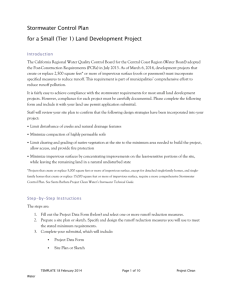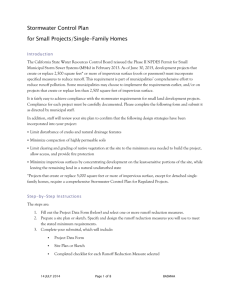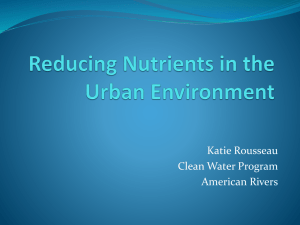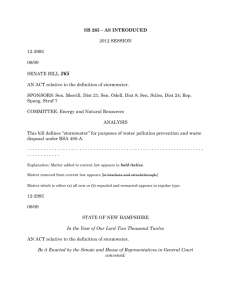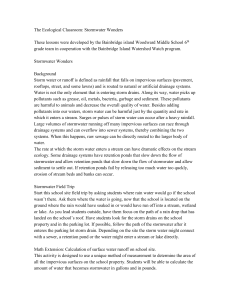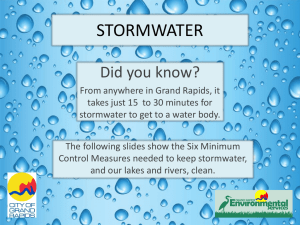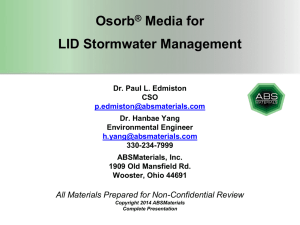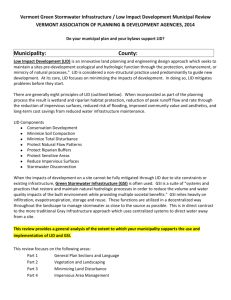Stormwater Control Plan Template for Small Land Development
advertisement
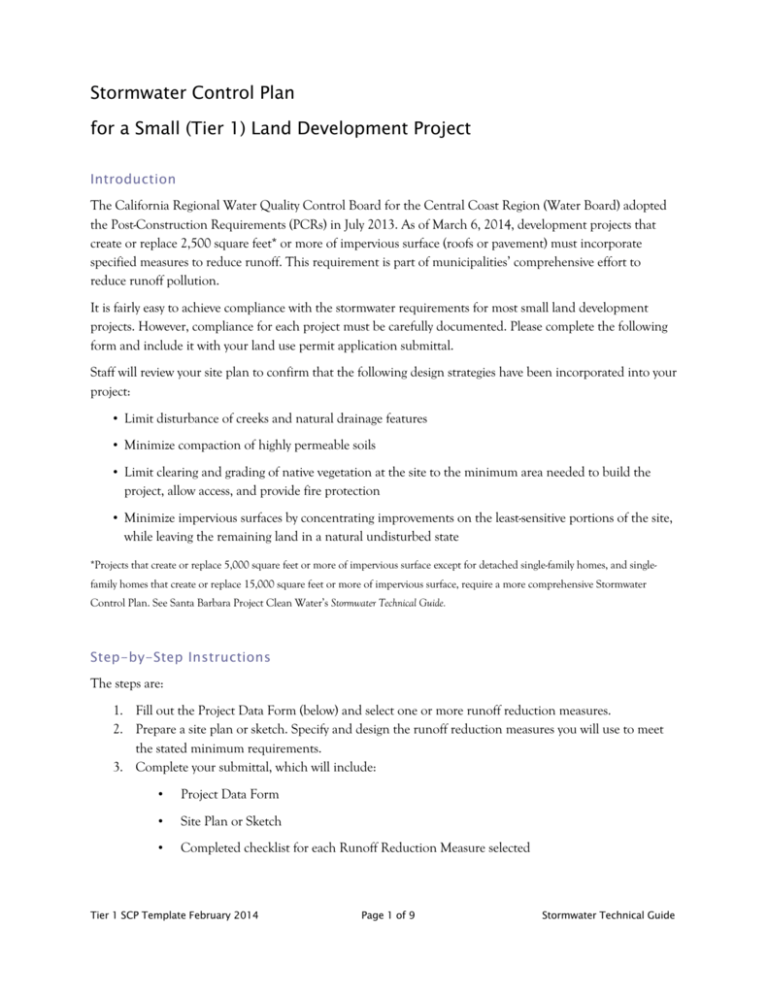
Stormwater Control Plan for a Small (Tier 1) Land Development Project Introduction The California Regional Water Quality Control Board for the Central Coast Region (Water Board) adopted the Post-Construction Requirements (PCRs) in July 2013. As of March 6, 2014, development projects that create or replace 2,500 square feet* or more of impervious surface (roofs or pavement) must incorporate specified measures to reduce runoff. This requirement is part of municipalities’ comprehensive effort to reduce runoff pollution. It is fairly easy to achieve compliance with the stormwater requirements for most small land development projects. However, compliance for each project must be carefully documented. Please complete the following form and include it with your land use permit application submittal. Staff will review your site plan to confirm that the following design strategies have been incorporated into your project: • Limit disturbance of creeks and natural drainage features • Minimize compaction of highly permeable soils • Limit clearing and grading of native vegetation at the site to the minimum area needed to build the project, allow access, and provide fire protection • Minimize impervious surfaces by concentrating improvements on the least-sensitive portions of the site, while leaving the remaining land in a natural undisturbed state *Projects that create or replace 5,000 square feet or more of impervious surface except for detached single-family homes, and singlefamily homes that create or replace 15,000 square feet or more of impervious surface, require a more comprehensive Stormwater Control Plan. See Santa Barbara Project Clean Water’s Stormwater Technical Guide. Step-by-Step Instructions The steps are: 1. Fill out the Project Data Form (below) and select one or more runoff reduction measures. 2. Prepare a site plan or sketch. Specify and design the runoff reduction measures you will use to meet the stated minimum requirements. 3. Complete your submittal, which will include: • Project Data Form • Site Plan or Sketch • Completed checklist for each Runoff Reduction Measure selected Tier 1 SCP Template February 2014 Page 1 of 9 Stormwater Technical Guide Step 1: Project Data Form Complete all fields. Project Name / Case File Number Application Submittal Date [to be verified by municipal staff] Project Location [Street Address if available, or intersection and/or APN] Name of Owner or Developer Project Type and Description [Examples: “Single Family Residence,” “Parking Lot Addition,” “Retail and Parking”] Total Project Site Area (acres) Total New Impervious Surface Area (square feet) [Sum of currently pervious areas that will be covered with new impervious surfaces] Total Replaced Impervious Surface Area [Sum of currently impervious areas that will be covered with new impervious surfaces.] Total Pre-Project Impervious Surface Area Total Post-Project Impervious Surface Area 1. Disperse runoff from roofs or pavement to vegetated area Runoff Reduction Measure(s) Selected (Check one or more) 2. Permeable pavement 3. Cisterns or Rain Barrels 4. Bioretention Facility or Planter Box Tier 1 SCP Template February 2014 Page 2 of 9 Stormwater Technical Guide Step 2: Delineate impervious areas and locations of runoff reduction measures Delineate the impervious area. On an attached site plan or sketch, show the impervious area—for example, a roof, or portion of a roof, or a paved area—that will drain to your runoff reduction measure. Typically these delineations follow roof ridge lines or grade breaks. Alternatively, show the type and extent of pervious paving. An example sketch is attached. Indicate the location and type of runoff reduction measure you’ve selected. At least one measure, designed to manage runoff from some amount of impervious area—or to avoid creating runoff—is required. For each measure selected, fill out the brief checklist to demonstrate how your design and submittal meet minimum standards. Step 3: Complete and submit your plan Your Stormwater Control Plan will accompany your land use application submittal and will include: 1. Project Data Form including the runoff reduction measures(s) selected 2. Site plan or sketch showing runoff management from impervious areas 3. Checklist of runoff reduction design standards (see below) Tier 1 SCP Template February 2014 Page 3 of 9 Stormwater Technical Guide Runoff Reduction Design Standards Checklist Measure 1: Disperse runoff from roofs or pavement to vegetated areas. This is the simplest option. Downspouts can be directed to vegetated areas adjacent to buildings, or extended via pipes to reach vegetated areas further away. Paved areas can be designed with curb cuts, or without curbs, to direct flow into surrounding vegetation. On the site plan, show: Each impervious area from which runoff will be directed, and its square footage. Connecting a roof leader to a vegetated area. The head from the The vegetated areas that will receive runoff, and the approximate square footage of each. eave height makes it possible to If necessary, explain in notes on the plan how runoff will be routed from impervious surfaces to vegetated areas. away from the building. route roof drainage some distance Confirm the following standards are met: Tributary impervious square footage in no instance exceeds twice the square footage of the receiving pervious area. On your sketch, show rough dimensions that will confirm this criterion is met. Roof areas collect runoff and route it to the receiving pervious area via gutters and downspouts. Paved areas are sloped so drainage is routed to the receiving pervious area. Runoff is dispersed across the vegetated area (for example, with a splash block) to avoid erosion and promote infiltration. Vegetated area has amended soils, vegetation, and irrigation as required to maintain soil stability and permeability. Any area drains within the vegetated area have inlets at least 3 inches above surrounding grade. Additional comments: Tier 1 SCP Template February 2014 Page 4 of 9 Stormwater Technical Guide Measure 2: Permeable Pavement Permeable pavements may include pervious concrete, pervious asphalt, porous pavers, crushed aggregate, open pavers with grass or plantings (turf block), open pavers with gravel, or solid pavers with open (non-grouted) joints. Show on your site plan: Location, extent and types of pervious pavements. Confirm the following standardsare met: No erodible areas drain on to permeable pavement. Subgrade compaction is minimal. Reservoir base course is of open-graded crushed stone. Base depth (3" or more) is adequate to retain rainfall and support design loads (more depth may be required). No subdrain is included or, if a subdrain is included, outlet elevation is a minimum of 3 inches above bottom of base course. Subgrade is level and slopes are not so steep that subgrade is prone to erosion. Rigid edge is provided to retain granular pavements and unit pavers. Solid unit pavers, if used, are set in sand or gravel with minimum 3/8 inch gaps between the pavers. Joints are filled with an open-graded aggregate free of fines. Permeable concrete or porous asphalt, if used, are installed by industry-certified professionals according to the vendor’s recommendations. Selection and location of pavements incorporates Americans with Disabilities Act requirements (if applicable), site aesthetics, and uses. Additional comments: Check with local Fire Department for applicability criteria using permeable pavement. Tier 1 SCP Template February 2014 Page 5 of 9 Stormwater Technical Guide Measure 3: Cisterns or Rain Barrels Use of cisterns or rain barrels to comply with this requirement may be subject to municipality approval. Planning and Building Permits may be required for larger systems. Show on your site plan: Impervious areas tributary to each cistern or rain barrel. Location of each cistern or rain barrel. Confirm the following standards are met: Rain barrels are sited at or above grade on a sound and level surface at or near gutter downspouts. Gutters tributary to rain barrels are screened with a leaf guard or maximum ½-inch to ¼-inchminimum corrosion-resistant metallic hardware fabric. Water collected will be used for irrigation only. Openings are screened with a corrosion-resistant metallic fine mesh (1/16 inch or smaller) to prevent mosquito harborage. Lids are secured to prevent entry by children. Rain barrels and gutters are to be cleaned annually. Additional comments: Tier 1 SCP Template February 2014 Page 6 of 9 Stormwater Technical Guide Measure 4: Bioretention Facility or Planter Box An above-ground planter box may be appropriate if the development site lacks level landscaped areas for dispersion and pervious pavements are not practical. Planter boxes and bioretention facilities can treat runoff from impervious surfaces 25 times their area (sizing factor of 0.04). Detailed design guidance for bioretention facilities is in the Stormwater Technical Guide. Show on your site plan: Impervious areas tributary to the facility. Flow-through planter built into a hillside. Flows Location and footprint of facility. from the underdrain and overflow must be Confirm the following standards are met: directed in accordance with local requirements. Ponding depth is 4"-6" minimum. Minimum 18" depth soil mix (60%-70% sand; 30%-40% compost) with minimum long-term infiltration rate of 5"/hour. Surface area of soil mix is a minimum 0.04 times the tributary impervious area. “Class 2 permeable” (Caltrans specification 68-2.02(F)(3) drainage layer 12" deep. No filter fabric. Perforated pipe (PVC SDR 35 or approved equivalent) underdrain. Connection with sufficient head to storm drain or discharge point. Underdrain has a clean-out port consisting of a vertical, rigid, non-perforated PVC pipe, connected to the underdrain via a sweep bend, with a minimum diameter of 4" and a watertight cap. Overflow outlet connected to a downstream storm drain or approved discharge point. Planter is set level. Emergency spillage will be safely conveyed overland. Plantings are suitable to the climate, exposure, and a well-drained soil. Irrigation system, if any, controlled as a separate zone. Additional comments: Tier 1 SCP Template February 2014 Page 7 of 9 Stormwater Technical Guide Useful Resources The following references may be useful for design. Designs must meet the minimum standard specifications herein. Santa Barbara Project Clean Water Stormwater Technical Guide. Available at http://www.sbprojectcleanwater.org Start At the Source: Design Guidance Manual for Stormwater Quality. Bay Area Stormwater Management Agencies Association, 1999. California Nevada Cement Association, www.cncpc.org Specifier’s Guide for Pervious Concrete, Colorado Ready Mixed Concrete Association. www.crmca.org Interlocking Concrete Pavement Institute http://www.icpi.org/ Porous Pavements, by Bruce K. Ferguson. 2005. ISBN 0-8493-2670-2 Tier 1 SCP Template February 2014 Page 8 of 9 Stormwater Technical Guide Example Sketch The example below illustrates the level of detail required. Not to Scale 16’ 10’ 25’ Tier 1 SCP Template February 2014 Page 9 of 9 Stormwater Technical Guide

